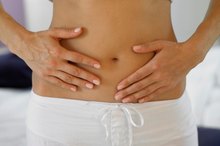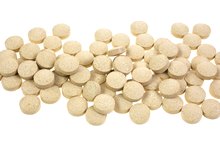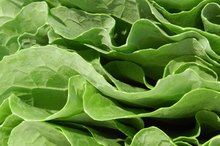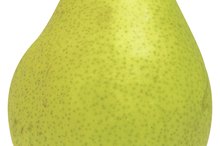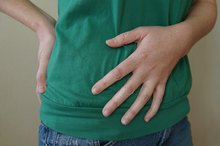Gallstones, Lecithin & Rowachol
Gallstones are small, pebble-like structures composed of the crystallized components of bile that develop in the gallbladder. Bile, made by the liver and stored in the gallbladder, helps the body to digest fats and it contains water, cholesterol, lipids, bile salts, protein, and bilirubin. Some of these constituents can harden to form gallstones, particularly cholesterol – which accounts for 80 percent of all gallstones – and bilirubin. The gallbladder may develop a number of small gallstones, one large stone, or a combination. Individuals who develop gallstones will require surgery or drug treatment.
Causes of Gallstones
Gallstones form when some of the constituents of bile are present in abnormal proportions, such as too much cholesterol, too much bilirubin, or not enough bile salts. Pigment gallstones -– those composed largely of bilirubin -– tend to form in individuals with liver cirrhosis, biliary tract infections, or hereditary blood disorders, such as sickle cell anemia. Cholesterol gallstones are more prevalent in women, individuals with a family history of gallstones, people who are overweight or have a diet high in fats and cholesterol and low in fiber, diabetics, the elderly, and individuals who rapidly lose weight or take cholesterol-lowering drugs. Some ethnic groups are also more susceptible, such as Native Americans.
- Gallstones form when some of the constituents of bile are present in abnormal proportions, such as too much cholesterol, too much bilirubin, or not enough bile salts.
- Pigment gallstones -– those composed largely of bilirubin -– tend to form in individuals with liver cirrhosis, biliary tract infections, or hereditary blood disorders, such as sickle cell anemia.
Gallstone Symptoms and Diagnosis
Medications That Cause Gallstones
Learn More
The most common symptom of gallstones is pain, which can occur suddenly and last for several hours. These attacks can cause pain in the upper abdomen, in the back and between the shoulder blades, and under the right shoulder. Other symptoms include nausea and vomiting, fever or chills, jaundice, and clay-colored stools.
If a patient is suspected of having gallstones, his doctor can use a variety of imaging techniques to confirm the diagnosis. The most common technique is ultrasound, and the patient’s abdomen will be carefully scanned to identify the gallstones. Other imaging techniques used include computerized tomography, cholescintigraphy, and endoscopic retrograde cholangiopancreatography. Blood tests can also be performed to check for infection, obstruction, pancreatitis, or jaundice.
- The most common symptom of gallstones is pain, which can occur suddenly and last for several hours.
- Blood tests can also be performed to check for infection, obstruction, pancreatitis, or jaundice.
Lecithin and Rowachol
Phospholipids increase the solubility of biliary cholesterol, preventing the formation of gallstones. One substance that is particularly high in phospholipids is lecithin, and lecithin supplementation has been used to treat gallstone patients, reducing biliary cholesterol. However, Alan R. Gaby, MD, reports in "Alternative Medicine Review" that clinical studies of lecithin as a treatment for gallstones are inconclusive and that there is no strong evidence to support using lecithin to prevent or treat gallbladder disease 1.
Another alternative medication for gallstones is Rowachol. Rowachol, a brand-name product, contains six plant monoterpenes and was first suggested as a treatment for gallstones in 1979 2. Patients receive two to three capsules of Rowachol per day and studies described by Gaby in "Alternative Medicine Review" reveal that Rowachol treatment can lead to partial or complete dissolution of gallstones in some patients 1. This publication also describes studies were Rowachol was used in combination with other treatments, such as chenodeoxycholic acid or ursodeoxycholic acid, which were more successful than administration of Rowachol alone. Lecithin and Rowachol can also be used in combination, but studies describing their efficacy are not available.
- Phospholipids increase the solubility of biliary cholesterol, preventing the formation of gallstones.
- One substance that is particularly high in phospholipids is lecithin, and lecithin supplementation has been used to treat gallstone patients, reducing biliary cholesterol.
Common Treatments for Gallstones
Side Effects of Gallstones
Learn More
Although alternative treatments for gallstones are available, the most common treatments are very different. Patients who suffer from frequent pain attacks due to gallstones are more likely to be recommended surgery to remove their gallbladder. The gallbladder is regarded as a nonessential organ and gallbladder removal is a common surgical procedure.
Patients who are unable to receive surgical treatment are given drugs to combat their condition. Some drugs, such as Actigall and Chenix, are taken orally and are aimed at dissolving cholesterol stones in the gallbladder. Another experimental treatment involves injecting a drug directly into the gallbladder in an attempt to dissolve the gallstones. Drug treatments work best in patients with small stones.
- Although alternative treatments for gallstones are available, the most common treatments are very different.
- Patients who suffer from frequent pain attacks due to gallstones are more likely to be recommended surgery to remove their gallbladder.
Related Articles
References
- Alternative Medicine Review; Nutritional Approaches to Prevention and Treatment of Gallstones; A Gaby; 2009
- Gut; Rowachol – A Possible Treatment for Cholesterol Gallstones; J Doran, MR Keighley and GD Bell; 1979
- Reshetnyak VI. Concept of the pathogenesis and treatment of cholelithiasis. World J Hepatol. 2012;4(2):18-34. doi:10.4254/wjh.v4.i2.18
- Goktas SB, Manukyan M, Selimen D. Evaluation of Factors Affecting the Type of Gallstone. Indian J Surg. 2016;78(1):20-6. doi:10.1007/s12262-015-1313-9
- Behari A, Kapoor VK. Asymptomatic Gallstones (AsGS) - To Treat or Not to?. Indian J Surg. 2012;74(1):4-12. doi:10.1007/s12262-011-0376-5
- Baiu I, Hawn MT. Gallstones and Biliary Colic. JAMA. 2018;320(15):1612. doi:10.1001/jama.2018.11868
- Lee JY, Keane MG, Pereira S. Diagnosis and Treatment of Gallstone Disease. Practitioner. June 2015;259(1783):15-9, 2.
- Mayo Clinic Staff. Gallstones. Mayo Clinic. Updated November 17, 2017.
- National Institute of Diabetes and Digestive and Kidney Diseases. Gallstones. National Institutes of Health. U.S. Department of Health and Human Services. Updated November 2017.
Writer Bio
Peter Branney has more than nine years of experience as a scientific researcher. He has contributed to scientific journals such as the "American Journal of Human Genetics," "PLoS Genetics," "PLoS One" and "Biology of the Cell." Branney holds a Ph.D., as well as a Bachelor of Science in biotechnology.

